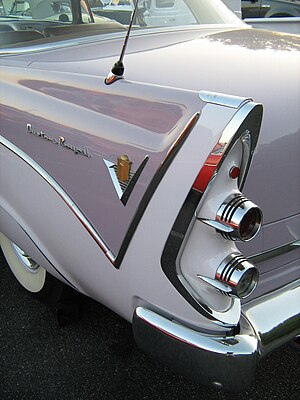
1950s American automobile culture has had an enduring influence on the culture of the United States, as reflected in popular music, major trends from the 1950s and mainstream acceptance of the "hot rod" culture. The American manufacturing economy switched from producing war-related items to consumer goods at the end of World War II, and by the end of the 1950s, one in six working Americans were employed either directly or indirectly in the automotive industry. The United States became the world's largest manufacturer of automobiles, and Henry Ford's goal of 30 years earlier—that any man with a good job should be able to afford an automobile—was achieved.[1] A new generation of service businesses focusing on customers with their automobiles came into being during the decade, including drive-through or drive-in restaurants and greatly increasing numbers of drive-in theaters (cinemas).
The decade began with 25 million registered automobiles on the road, most of which predated World War II and were in poor condition; no automobiles or parts were produced during the war owing to rationing and restrictions. By 1950, most factories had made the transition to a consumer-based economy, and more than 8 million cars were produced that year alone. By 1958, there were more than 67 million cars registered in the United States, more than twice the number at the start of the decade.[2]
As part of the U.S. national defenses, to support military transport, the National Highway System was expanded with Interstate highways, beginning in 1955, across many parts of the United States. The wider, multi-lane highways allowed traffic to move at faster speeds, with few or no stoplights on the way. The wide-open spaces along the highways became a basis for numerous billboards showing advertisements.
The dawning of the Space Age and Space Race were reflected in contemporary American automotive styling. Large tailfins,[3] flowing designs reminiscent of rockets, and radio antennas that imitated Sputnik 1 were common, owing to the efforts of design pioneers such as Harley Earl.[4]
- ^ Weiss (2003), p. 34.
- ^ Cite error: The named reference
natpetnewswas invoked but never defined (see the help page). - ^ Gunnell (2004), p. 15.
- ^ Cite error: The named reference
century2was invoked but never defined (see the help page).
© MMXXIII Rich X Search. We shall prevail. All rights reserved. Rich X Search
